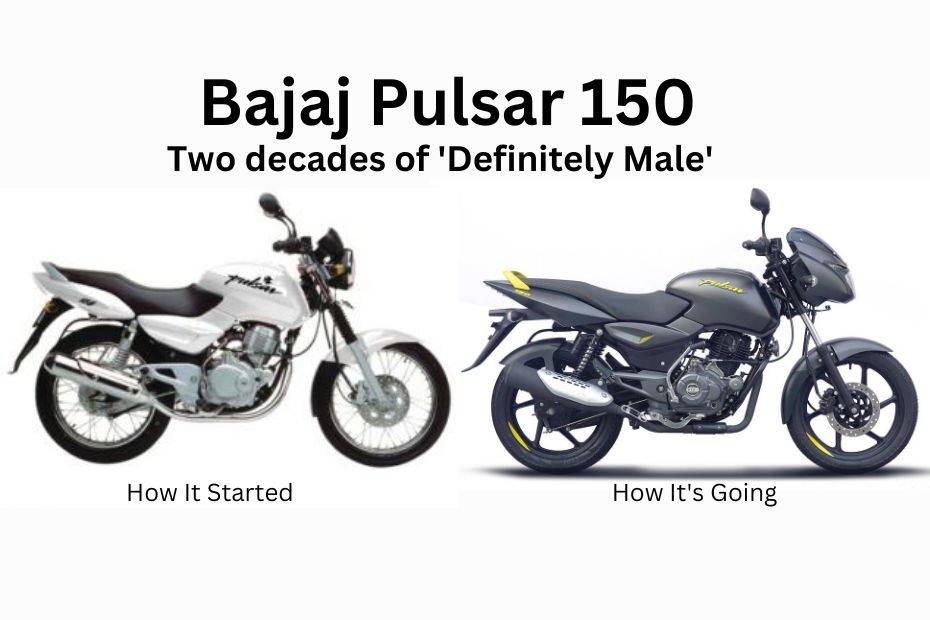Flashback Friday: Bajaj Pulsar 150 - Bringing Sport Riding To The Masses
Published On May 12, 2023 04:00 PM By Sudipto Chaudhuryfor Bajaj Pulsar 150
- 2232 Views
It may not have been the first sporty 150, but the Bajaj Pulsar has flown the flag long after its rivals have bowed out

The Bajaj Pulsar 150 is the default choice for anyone looking for a decently quick and relatively affordable street bike. Moreover, it has led to multiple iterations ranging from 125cc to 250cc. In fact, in its concept stage even the Dominar 400 was named ‘Pulsar CS 400’.
Today, though, we will be talking about the Pulsar 150’s exciting ride that has spanned over two decades. So here goes:
‘Original’ Pulsar 150 (2001)

The Bajaj Pulsar 150 was conceptualised so as to dent the market share of the then Hero Honda CBZ, and TVS Fiero. Its looks were inspired by the Honda Hornet 600: same round headlight, twin-pod instrument console, bulbous 16-litre tank, and flaring rear panels; even the font for the ‘Pulsar’ decal were similar.
Its 150cc engine made 12.5PS and 12Nm, modest by today’s standards, but par for the course back then. What set it apart, though, was the 240mm disc brake, available as standard.
UG-1 Pulsar 150 (2003)

The first update addressed concerns with the gearbox, along with the addition of Digital Twin Spark Injection (DTSi) tech, which led to a slight bump in specs, to 13PS and 12.5Nm. It also received a visual update, with a ‘bikini’ fairing that enclosed the headlight, flanked by pilot lights.
UG- 2 Pulsar 150 (2005)

The second update brought with it 17-inch alloys, and gas-charged rear shocks (which softened the thuds over sharp bumps). Moreover, the introduction of ExhausTEC (Exhaust Torque Emission Control) tech, an expansion chamber of sorts located ahead of the exhaust end can, slightly improved the low-end power delivery.
UG-3 Pulsar 150 (2006)

This update brought in the visual signature of the Pulsar that continues till this day. From the front, the Pulsar got the ‘wolf eye’ pilot lamps. Next, the twin-pod analogue cluster was replaced by a semi-analogue digital cluster with a shift light. The tank was also made a bit sleeker, and capacity was reduced to 15 litres. This version also saw the introduction of the backlit switchgear. And finally, the halogen bulb taillight was replaced by a twin LED unit.
UG-4 Pulsar 150 (2009)

The 2009 iteration sported just a few changes. The two major ones were the clip-on handlebar replacing the traditional unit, and the introduction of DC lighting. A minor update, meanwhile, was the tank cowl, added for visual uniformity with the Pulsar 200 and Pulsar 180.
Dual-tone paint schemes (2012-13) and Neon Edition (2019)


Save for the introduction of an optional 220mm rear disc, subsequent Pulsars received purely cosmetic updates: the former inspired by the then recently launched Pulsar NS200, the latter by the smaller Pulsar 125 (with contrast-coloured decals) launched in 2019.
Pulsar P150 (2022)


The ‘all-new’ Bajaj Pulsar P150 is inspired by the Pulsar N160, right from its headlight to its tank shape. Its 149.68cc mill makes 14.5PS and 13.5Nm (0.5PS and 0.25Nm more than the Pulsar 150). It’s available in two variants, but with a host of changes. The single disc variant gets a 130mm rear drum brake, single-piece seat, and single-unit handlebar and forward-set footpegs for an upright stance. The twin-disc variant, meanwhile, gets a 230mm rear disc, split seats, clip-on handlebar, and mildly rear-set footpegs.
Summing up, many manufacturers and models have come and gone in the two decades since the Pulsar 150 first arrived. But the affordable to buy and easy to maintain Pulsar 150 – with two models currently on sale – has been and will no doubt continue to be a fixture on our streets.
